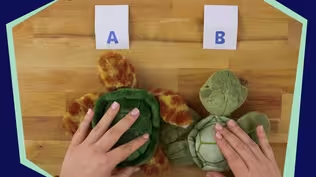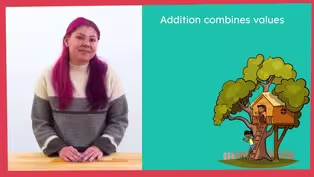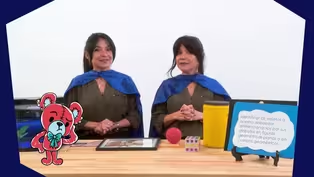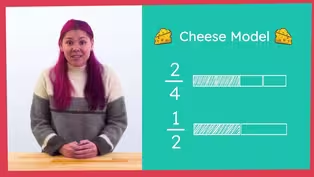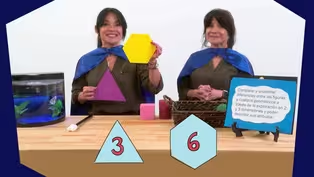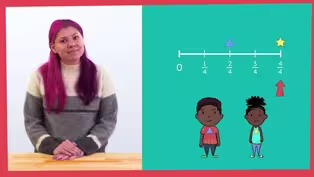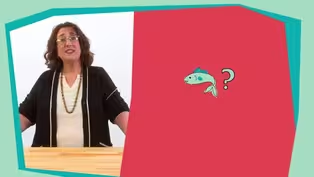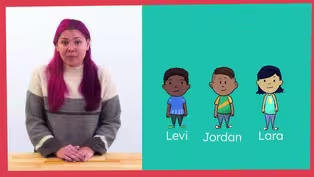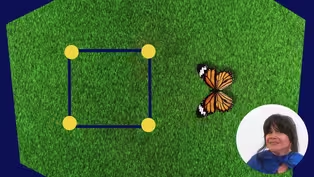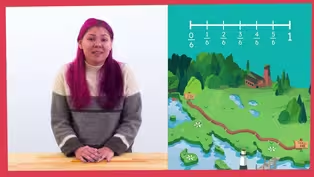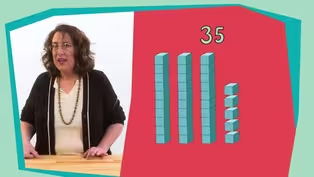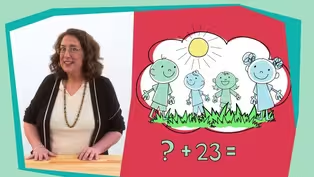
Episode 45 | Math Lessons
5/15/2021 | 28m 46sVideo has Closed Captions
Math lessons for early learners, led by NC teachers.
The first lesson (aimed at PreK-K) teaches learners to compare objects & measure descriptions. The second lesson (aimed at 1st-2nd graders) teachers students to solve addition and subtraction word problems, within 20, with unknowns. Classroom Connection is your At-Home Learning companion where children love to learn. All lessons are led by NC educators.
Problems playing video? | Closed Captioning Feedback
Problems playing video? | Closed Captioning Feedback
At-Home Learning Presents: Classroom Connection is a local public television program presented by PBS NC

Episode 45 | Math Lessons
5/15/2021 | 28m 46sVideo has Closed Captions
The first lesson (aimed at PreK-K) teaches learners to compare objects & measure descriptions. The second lesson (aimed at 1st-2nd graders) teachers students to solve addition and subtraction word problems, within 20, with unknowns. Classroom Connection is your At-Home Learning companion where children love to learn. All lessons are led by NC educators.
Problems playing video? | Closed Captioning Feedback
How to Watch At-Home Learning Presents: Classroom Connection
At-Home Learning Presents: Classroom Connection is available to stream on pbs.org and the free PBS App, available on iPhone, Apple TV, Android TV, Android smartphones, Amazon Fire TV, Amazon Fire Tablet, Roku, Samsung Smart TV, and Vizio.
Providing Support for PBS.org
Learn Moreabout PBS online sponsorshipMore from This Collection
Math lessons for early learners, led by NC teachers.
Video has Closed Captions
Math lessons for early learners, led by NC teachers. (28m 46s)
Video has Closed Captions
Math lessons for early learners, led by NC teachers. (28m 46s)
Video has Closed Captions
Math lessons for early learners, led by NC teachers. (28m 46s)
Video has Closed Captions
Math lessons for early learners, led by NC teachers. (28m 46s)
Video has Closed Captions
Math lessons for early learners, led by NC teachers. (28m 46s)
Video has Closed Captions
Math lessons for early learners, led by NC teachers. (28m 46s)
Video has Closed Captions
Math lessons for early learners, led by NC teachers. (28m 46s)
Video has Closed Captions
Math lessons for early learners, led by NC teachers. (28m 46s)
Video has Closed Captions
Math lessons for early learners, led by NC teachers. (28m 45s)
Video has Closed Captions
Math lessons for early learners, led by NC teachers. (28m 46s)
Video has Closed Captions
Math lessons for early learners, led by NC teachers. (28m 45s)
Video has Closed Captions
Math lessons for early learners, led by NC teachers. (28m 46s)
Providing Support for PBS.org
Learn Moreabout PBS online sponsorship[cheerful upbeat music] ♪ - Welcome to "Classroom Connection."
I'm your host Mr. R and I'm also a teacher.
I hope you'll join me in the classroom as we learn from teachers all across this beautiful state of North Carolina.
- Hello, super learners, I'm Ms. L. I am so glad you're joining me today.
Are you ready for a math adventure?
Well, let's get started with a song.
♪ Hello, super learners, how are you ♪ ♪ Hello, super learners, how are you ♪ ♪ I'm so glad you're here today ♪ ♪ And I hope you feel the same ♪ ♪ Hello, super learners, how are you ♪ Well, I feel great today, and I hope you do too.
Now guess what, it's time for some math power warmups.
We're gonna count to 20.
Are you ready?
Here we go.
♪ 1, 2, 3, 4, 5, 6, 7 ♪ ♪ 8, 9, 10, 11, 12 ♪ ♪ 13, 14, 15, 16, 17, 18 ♪ ♪ 19, 20 ♪ ♪ That was fun ♪ Let's count up to 20 one more time.
Let's snap count, all right?
Ready?
[snapping fingers] 1, 2, 3.
4, 5, 6.
7, 8, 9, 10.
♪ Let's keep going ♪ 11, 12, 13.
14, 15, 16.
17, 18, 19, 20.
Yes, super learners are the best, and you really are the best, super learners.
I'm getting warmed up, are you?
All right, well, how about one more time counting to 20?
But let's just do this in Spanish, how about it?
[counting in foreign language] We made it to 20 again, awesome job.
We've counted to 20 three different ways.
So now let's review our colors.
Let's say them in English and in Spanish.
Rojo, red.
Naranjo, orange.
Amarillo, yellow.
Verde, green.
Azul, blue.
Morado, purple.
Cafe, brown.
Negro, black.
Blanco, white.
Gris, gray.
Look for all of these colors in the world today.
Awesome job.
All right, we have one more warmup.
All right, let's play the shapes game.
You'll see a shape and then you'll say its name, and you can say it in English or in Spanish.
Here we go.
Cuadrado, square.
Circulo, circle.
Triangulo, triangle.
Rectangulo, rectangle.
Rombo, rhombus.
Trapezoide, trapezoid.
Hexagono, hexagon.
Cubo, cube.
Cono, cone.
Cilindro, cylinder.
Esfera, sphere.
Awesome!
Are you all warmed up?
I am.
So you know what it's time for?
Our Math Mission of the Day, yes.
So we're gonna check in with Sparkles the Fish to see what our mission is.
Let's see.
Sparkles, hey, do you have a mission for us?
It looks like you do.
A special math mission, I'm excited.
Let's see what Sparkles has.
"Dear super learners, "your mission today is to compare two groups of objects "to see which one has more or less."
There are four group comparisons today, it says.
Four groups?
That's a lot.
Super learners, I know we can do this mission.
First we have to put our capes on.
Let's see, can you put on your invisible cape?
I'm gonna put mine on.
Every time I put on my cape I feel like I can do any math mission and I know that I can, especially with your help.
All right, cape's on, ready?
Math power on, let's go.
Look at our first challenge.
It's been right here in front of me.
What a fun challenge this will be.
Look at all of these beautiful flowers I've grown.
I worked hard to grow these perfect flowers for my friends.
Friends like you and friends like Sparkles.
When I planted these seeds I didn't know what colors would grow, but it's so beautiful.
I have pink flowers, I have blue, I have yellow.
You know what, I think we should count to see how many flowers I have.
Can you help me?
Let's see, I have one, two, three, four, five, six, seven, eight, nine.
Wow, I have nine beautiful flowers.
You know what I would like to do for this mission?
I would like to place a special flower for Sparkles right here in this vase.
But I wonder which flower is the right height.
Let's cut the tall flowers.
I know that this is a tall vase for Sparkles, so we'll cut the tall ones first and we'll look to see which one fits best.
Which flowers look to be the tallest to you?
I agree, I think this blue one and this yellow one, they look to be the tallest.
So now we're gonna safely cut with some scissors.
Now remember, only use scissors with a trusted adult, okay?
All right, here's our first flower.
Beautiful, we'll put it right here.
And here's our second flower, ooh.
Got it, beautiful.
All right, so, a quick and easy way to measure is to line up or stand up the ends of objects, this way we have an accurate measurement of which one is tall and which one is short.
So let's stand up each flower by the vase and then in the vase to see which one is tallest.
Hmm, look here.
Can you tell which one is the tallest?
I think the blue one is the tallest too.
Let's see how it fits in the vase.
That is perfect.
Let's see how the other one might look.
The shorter one.
It sticks out just a little bit funny.
We'll go with the blue one.
This one is taller and it fits better.
It sticks out of the vase more, this one wouldn't.
We can tell this because it's taller from one end to the other.
It sticks out more.
We can see that it's taller by the way it sticks out.
Awesome, well, we found the perfect flower, and I can save this for another friends.
Great work.
Sparkles will love this tall beautiful blue flower, and like I said we'll save the others for friends.
Well, super learners, I think we're ready for our next math comparison challenge, and oh my goodness I think this mission includes turtles.
I love turtles, especially small turtles.
They are both small but I want to know which turtle is the smallest.
Since these turtles aren't real, we can move them and touch them and measure.
We know that if we are going to measure them we need to have them lined up on the same end.
Let's put them next to each other and see.
All right.
So here is turtle A and turtle B, we've got them lined up.
Can you point to the one that reaches further?
That's right, turtle A reaches further from one end to the other.
It's longer.
This means that turtle B is shorter.
Great job, super learners.
Now let's see which one is heavier.
Since these turtles aren't real, like I said, I can pick them up.
So let's see which is heavier and which is lighter.
Okay, holding these I can tell that I think this one is heavier.
And this one feels a bit lighter.
But you know what, to make sure, I have a special tool right here called a balance or a scale.
What we can do is check to see which one is definitely heavier.
I'll place them on these pans and whichever side goes down means that that turtle is heavier and this side would mean that that turtle is lighter, so let's see.
I'm gonna place the turtles on the pans safely.
Okay, right now that one's heavier 'cause there's nothing on this side.
So let's add this little short.
Remember, this was the shorter turtle, so I wonder if it will be heavier or lighter.
Oh my goodness, super learners.
This turtle is shorter but it is heavier.
That is wild.
And this turtle is longer but it is lighter.
Great work, super learners, that was so fun.
So let's check back with Sparkles to see if we've completed our mission today.
Hey Sparkles, did we complete it?
Let's see.
We did!
Congratulations, super learners.
You used your math powers to complete the mission.
So, what's the time to do now?
It's time to review.
So today we compared and measured objects.
We know an easy way to measure is to line things up or stand them up next to each other.
This way we have an accurate measurement.
And we can hold things to feel which one might be heavier or lighter.
And we also use measurement words to describe them, like heavier, lighter, long, tall, short, we even talked about big and small.
Practice comparing objects today.
Super learners, you can share your math power by showing it to someone.
Thank you, super learners, for going on a math mission with me today.
And a special thank you to Sparkles.
Thank you, Sparkles.
Remember, you have the power to be super at math.
Adios, friends.
Bye.
- What a cool math lesson.
I cannot wait for the next lesson.
Practice makes perfect, they say.
But really, I just like getting better one day at a time.
Each day is a new opportunity to learn and grow, and I'm glad we got to do it together.
- [Children] Lalo's Lunchbox.
- Hello, friends, my name is Lalo and this is my lunchbox.
[lunchbox clanks] [chuckles] Lunchbox just said it's happy to see you again.
[lunchbox clanks] Oh, excuse me.
[bright music] [Lalo screams] [bells chime] I'm back inside my lunchbox and I'm now a cartoon.
- I'm thinking Margherita pizzas would be perfect to make with these... queen muffins.
- I thought Margheritas were a cocktail.
- That's a completely different kind of Margherita.
- Hey, red cap man, what do you think?
Hey?
- Lalo?
Hey, Lalo?
- What's over there?
[crowd cheering] It looks like some type of a sporting event.
- [Announcer] Welcome, sports fans, to Mozzarella Mountain Basil Board Final.
Today it's all about lunchbox gold.
In purple, the grape.
[Grape grunts] His first time on the slopes of Mozzarella, experts wonder if he's got the juice to go all the way.
In the orange, baby carrot.
- Hey.
- This kid can shred.
She's the fastest in basil board history with the world championship in 2015.
And in red, the cherry tomato.
- Yeah!
- He burst to the top of the basil board standings and is a crowd favorite.
- Wowzers, this is gonna be good!
- [Announcer] All the racers handpicked their basil and are at the starting line.
It's time to see who will tame Mozzarella Mountain.
Racers, on your marks, get set.
[horn blares] [crowd cheers] Baby carrot is in the lead, closely followed by grape, cherry tomato bringing up the rear.
[grape grunts] - Uh-oh.
- [Announcer] What a grape move!
I mean, great move.
Now that grape is winning, that carrot is getting crushed.
The grape looks in trouble.
[grape splashes] [crowd gasps] Oh, the grape spilled his guts all over the crowd.
He's out of the race indefinitely.
Baby carrot is in the lead, but the cherry tomato is- - Yeah!
- [Announcer] Rolling out front.
They come to the first right turn.
Let go!
[carrot screams] [bright music] [bell dings] [spring boings] - Huh.
- [Announcer] Baby carrot won't be returning to the finals.
It's all up to cherry tomato.
So far he's given a flavorful performance, but will he taste victory?
Wow, cherry tomato is great with basil.
He's so tasteful on Mozzarella.
Cherry Tomato wins the gold!
[crowd cheers] - Whoa!
I'm back.
- There you are.
Should we make Margherita pizzas out of these?
These would be the pizza crust.
- What's in a Margherita pizza?
- Cherry tomatoes, basil, and mozzarella.
- That's a winning combination.
- Did you know the average yawn lasts six seconds?
One, two, three, four, five, six.
Next time you yawn, count to see how long it lasts.
But you won't be yawning any time soon 'cause we have a super cool math lesson for you.
This will help count down those seconds.
- Hi friends, my name is Dawn.
Splat and I are so happy to be here with you today.
Do you like cookies?
We love to eat cookies.
Today we are going to have fun solving a problem about cookies.
But before we get started, let's take some time to get a few things.
You might want to get something to write with, some paper or a whiteboard and marker, and a stuffed animal or trusted adult to talk to.
I'll wait for you right here while you get what you need.
[bright music] Welcome back.
Let's get started.
I have a friend, Moesha, who also loves cookies.
She eats cookies all the time.
Here is a picture of Moesha's cookies.
Today we are going to read a mathematical story about Moesha and some cookies.
Before we get started, though, let's exercise our brain and get it ready to do math work so we can be fit mathematicians.
Will you join me?
Let's get on our feet and find five objects in our house.
I'm gonna find five objects too.
[bright music] Okay, I found my five objects.
Do you have your five objects?
Great job.
Let's count them together.
One, two, three, four, five.
Now let's take one object away.
I'll take away my scissors.
So we started with five objects and then we took one object away, so how many do we have left?
You're right, we have four.
One, two, three, four.
Because five objects take away one is four.
Now let's do it again.
Let's go find six objects in your house.
I'll find six objects too.
[bright music] I have my six objects.
Did you find your six objects?
Great job, let's count them together.
One, two, three, four, five, six.
Now let's take away four objects.
One, two, three, four.
So we started with six objects and then we took away four objects, so how many do we have left?
That's right, we have two, one two.
Because six objects take away four objects is two.
Wow, I feel really energized and ready to focus on helping Moesha figure out her cookies.
Your job today is going to be to figure out how many cookies Moesha ate.
Let's read a little bit about Moesha to find other about her cookies.
Moesha's mom baked some cookies.
There are some cookies on the table.
Moesha ate some of the cookies.
And then there were some cookies left on the table.
What are you picturing in your mind?
Tell a friend or a stuffed animal what you are picturing.
I'm picturing cookies on the table and Moesha sitting at the table and eating them.
Let's read a little more about Moesha.
Moesha's mom baked some cookies.
There are 10 cookies on the table.
Moesha ate some of the cookies.
Then there were some cookies left on the table.
What do we know now that we didn't know before?
Exactly, we now know that Moesha has 10 cookies on the table.
How many cookies do you think Moesha ate?
Moesha could have eaten one or three or even ten cookies.
Let's keep reading.
Moesha's mom baked cookies.
There are 10 cookies on the table.
Moesha ate some of the cookies.
Then there were 3 cookies left on the table.
What do we know now that we didn't know before?
Yes, we now know that there are only 3 cookies left on the table.
What questions could we ask about this math story?
Think of a question about Moesha and the cookies.
Share your question with a trusted adult or stuffed animal and then whisper it to Splat and me.
I'm gonna listen in for the whispers.
I hear a whisper that says we could ask, how many cookies did Moesha eat from the table?
That's a great question.
Let's read a little more about Moesha.
Moesha's mom baked cookies.
There are 10 cookies on the table.
Moesha ate some of the cookies.
Then there were 3 cookies left on the table.
How many cookies did Moesha eat?
What is the question in this story?
Yes, the question is asking, how many cookies did Moesha eat?
Do you think you have all the information you need to answer that question?
Yes, you do have all the information you need.
I'd like for you to think about how you can solve this problem.
Would you tell a trusted adult or stuffed animal how you would solve the problem?
I hear some great answers.
Splat always helps me solve math stories.
He just told me a way that I can solve this problem.
Splat says that we can use a tool called an open number line.
We used this before and so now we're gonna try it again.
You can do it with me on your paper if you'd like to.
There were 10 cookies on the table, so we would draw a line and add 10 to the right side of the number line.
Then Moesha ate some of the cookies.
Now there are 3 left.
We will write the number 3 on the left side of the number line.
Next, let's count down from 10 to 3 and find out how many cookies Moesha ate.
As you count with me, we'll make humps as we jump.
Ready?
We'll begin at 10.
9, 8, 7, 6, 5, 4, 3.
I wonder how many times we hoped from 10 to 3.
Do you know how many times we hoped?
Tell a friend or a stuffed animal.
Okay, let's count our hops to see if we are correct in knowing how many cookies Moesha ate.
The hops are the number of cookies Moesha ate, so be sure to write the numerals over the hops as you count.
1, 2, 3, 4, 5, 6, 7.
7 hops, that means Moesha ate 7 cookies.
Wow, that was really great work on the number line.
In just a bit we will solve this problem using another strategy, but first let's take a math movement break to give our brains a rest.
Let's exercise our numbers counting down from 10 for inspiration.
Are you ready to move your body to each number?
Let's stand up and let's go.
First we'll do ten twists.
One, two, three, four, five, six, seven, eight, nine, ten.
Next let's do nine hops.
One, two, three, four, five, six, seven, eight, nine.
Great job.
Next is eight arm circles.
One, two, three, four, five, six, seven, eight.
Seven knee bends, ready?
One, two, three, four, five, six, seven.
Next let's do six arm stretches.
One, two, three, four, five, six.
All right, five knee braces is next.
Five, four, three, two, one.
Let's do four side bends.
One, two, three, four.
Three toe races.
One, two, three.
Two head nods.
One, two.
And one big jump.
That was fun, exercising our math minds by counting down from 10.
Now that we're energized, Splat and I will show you another way to solve our problem.
Remember, our problem is Moesha's mom baked cookies.
There are 10 cookies on the table.
Moesha ate some of the cookies.
Then there were 3 cookies left on the table.
How many cookies did Moesha eat?
Splat says another way to solve the problem would be to use a 10 frame.
To do this, let's put 10 counters in the 10 frame.
Next let's pull off some of the counters until we only have 3 left.
The ones we pulled off are the ones that Moesha ate.
1, 2, 3, 4, 5, 6, 7.
Moesha ate 7 cookies.
An equation we might write to go with our story could be 10 minus 7 equals 3.
This would match because Moesha began with 10 cookies, then she ate some, which we know is 7, and she had 3 left.
So 10 minus 7 equals 3.
Before Splat and I go we'd love to hear you talk about what you learned today.
I have this sentence starters that we can use to help us talk.
They say, today I learned, and I can.
So if I were doing this I might say, today I learned how to solve a math story with a missing number.
I can use a number line to help me figure out math stories where numbers are missing.
Okay, it's your turn.
Let's read together and you can finish the story.
Today I learned.
Okay, our next sentence, I can.
Super job talking about your learning.
Splat and I enjoy hearing you talk about math.
Friends, Splat and I have to go now, but you did such a great job of solving the mathematical story of how many cookies Moesha ate.
We used an open number line to solve the number of cookies Moesha ate.
Splat and I hope you enjoyed today and we hope to see you soon.
- Hello, my friends.
All this learning can be exciting but sometimes I still get scared that I'm not learning as fast as other people or maybe I'm not as good at learning as some of my other friends.
You know what helps me when I feel like that?
Man, I give myself a big squeeze, and tell myself one thing that I know I love about me.
Right now, one thing I love about me is this wonderful hair.
I know.
It makes me feel better already to say something positive.
Everyone learns differently and that's so cool.
I love being myself and I love that you are you.
What's one thing you love about yourself?
[cheerful upbeat music] ♪


- Home and How To

Hit the road in a classic car for a tour through Great Britain with two antiques experts.












Support for PBS provided by:
At-Home Learning Presents: Classroom Connection is a local public television program presented by PBS NC
